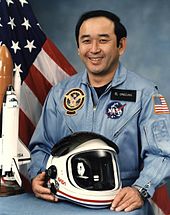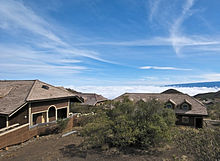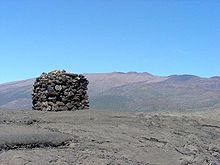- Onizuka Center for International Astronomy
-
The Onizuka Center for International Astronomy, also known as Hale Pōhaku, is a complex of support facilities for the telescopes and other instruments that comprise the Mauna Kea Observatory atop Mauna Kea, on Hawaiʻi island.
Contents
History
A few rustic cabins named Hale Pōhaku (which means "stone house" in the Hawaiian language[1]) were built by the Civilian Conservation Corps on the southern slope of Mauna Kea in the 1930s for hunters and other explorers.[2] A rough jeep trail was built in 1964 under Governor John A. Burns, and a small telescope determined that Mauna Kea would be an ideal place for an astronomical observatory. The Hale Pōhaku area was used as a construction camp for the building of the observatories through the 1970s, and the road realigned in 1975. A permanent complex of buildings was constructed in 1983 known as the Mid-Level Facility.[3]
 Astronaut Ellison Shoji Onizuka (1946–1986)
Astronaut Ellison Shoji Onizuka (1946–1986)
The Mid-Level Facility was renamed for the Hawaiʻi-born astronaut Ellison Onizuka, who died in the Space Shuttle Challenger disaster in 1986.[4] It is located at the 9,300-foot (2,800 m) elevation, south of the summit at 19°45′41″N 155°27′22″W / 19.76139°N 155.45611°WCoordinates: 19°45′41″N 155°27′22″W / 19.76139°N 155.45611°W, up Mauna Kea Access Road from the Saddle Road (Route 200).
The center consists of dormitories with sleeping accommodation for 72, as well as a main building which houses the shared facilities such as cafeteria, laundry, and common room. Astronomers or technicians normally spend up to 24 hours at Hale Pōhaku to acclimatize to the altitude, before proceeding to the summit at almost 14,000 feet (4,300 m). There is no admission to these support facilities for the general public. The center is operated by the Institute for Astronomy of the University of Hawaii.[5]
The harsh conditions of the observatories require ongoing maintenance, with technicians and construction workers being common residents. Originally any astronomer wishing to use the observatory needed to stay at these facilities to physically be present during the nights they were assigned to use the telescopes. Although first-time users of the observatories are still encouraged to actually travel to the summit to familiarize themselves with the instruments, most observations can now be done over the Internet. Often the work is done in teams, with a staff of two at the summit, and others connected by teleconference at Hale Pōhaku, the University of Hawaii at Hilo, University of Hawaii at Manoa, or the researcher's office.[6] W. M. Keck Observatory reported 90% of observations were remote by 2002, many from their facility in Waimea, on the plateau north of the mountain, and automation allowed control from California.[7]
Visitors
A traditional Hawaiian altar on the Saddle Road near the Mauna Kea access road
Just below the support complex, a Visitor Information Station at 19°45′33″N 155°27′22″W / 19.75917°N 155.45611°W, has its own parking lot for visitors. The VIS houses informational displays, and shows videos depicting the history and work of the observatory. Every evening it hosts a stargazing program in which a small telescope is set up outside the building and visitors are shown various stars, planets and other interesting features of the night sky. Amateur astronomers also come here to set up their own telescopes, since the altitude is already high enough for the seeing to be much better than lower down the mountain.[8]
The Onizuka Center is at the end of the paved road, and the farthest a regular car can go towards the summit. As of 2010[update], four wheel drive vehicles with well-maintained brakes are required to continue on the steep and twisting gravel road to the summit. Since conditions can change quickly, visitors are advised to get up-to-date information before going.
Those who do intend to visit the summit are also strongly advised to spend at least half an hour, or better three or four hours, at the mid-level in order to acclimatize to the higher elevation, and so reduce the possibility of suffering potentially dangerous altitude sickness.[9] Further below the visitor station is a camp for construction workers. The three facilities are kept separate because scientists generally work at the summit during night hours and need to sleep during the day, while construction and tours are restricted to daylight hours.[3]
Related sites
The Keck Observatory on the summit is sometimes open for visitors during daylight hours, but otherwise only scientists are allowed inside observatory facilities. Some commercial tours continue from the center to the summit until it is closed to the public at sunset.[10] Other Mauna Kea recreation opportunities include Mauna Kea State Recreation Area, and the Mauna Kea Trail which leads from the VIS through the Mauna Kea Ice Age Reserve to the summit. A small museum also dedicated to Onizuka is located at the Kona International Airport.[11] The ʻImiloa Astronomy Center of Hawaii in Hilo on the University of Hawaii at Hilo campus includes a larger museum and planetarium that is more easily accessible to visitors.[12]
References
- ^ Mary Kawena Pukui and Samuel Hoyt Elbert (2003). "lookup of Pōhaku ". in Hawaiian Dictionary. Ulukau, the Hawaiian Electronic Library, University of Hawaii Press. http://wehewehe.org/gsdl2.5/cgi-bin/hdict?j=pk&l=en&q=Pohaku&d=. Retrieved October 9, 2010.
- ^ "Recreation: Enjoying Mauna Kea's Unique Natural Resources". Mauna Kea Mountain Reserve Master Plan. Institute for Astronomy - University of Hawaii. http://www.hawaii.edu/maunakea/7_recreation.pdf. Retrieved August 27, 2010.
- ^ a b "Mauna Kea Science Reserve Master Plan: Education and Research". University of Hawaii. June 16, 2000. http://www.hawaii.edu/maunakea/6_education.pdf. Retrieved August 31, 2010.
- ^ "Mauna Kea Comprehensive Management Plan: UH Management Areas". University of Hawaii. January 2009. http://www.maunakeacmp.com/files/MaunaKea_CMP.pdf. Retrieved August 19, 2010.
- ^ "Services at Hale Pohaku Managed by Mauna Kea Support Services". June 2005. http://irtfweb.ifa.hawaii.edu/observing/servicesHalePohaku.pdf. Retrieved August 26, 2010.[dead link]
- ^ "Computers and Remote Observing", NASA Infrared Telescope Facility web site (Institute for Astronomy), http://irtfweb.ifa.hawaii.edu/observing/remote_obs/, retrieved August 30, 2010
- ^ Robert I. Kibrick; Brian Hayes; Steven L. Allen; Albert Conrad (November 27, 2002). "Remote observing with the Keck Telescopes from multiple sites in California". Advanced Global Communications Technologies for Astronomy II 4845: 80. doi:10.1117/12.456587.
- ^ "Visitor Information Station". Onizuka Center for International Astronomy official web site. University of Hawaii Institute for Astronomy. http://www.ifa.hawaii.edu/info/vis/. Retrieved August 26, 2010.
- ^ "Mountain Hazards". Onizuka Center for International Astronomy official web site. University of Hawaii Institute for Astronomy. http://www.ifa.hawaii.edu/info/vis/mountain%20hazards.html. Retrieved August 30, 2010.
- ^ "Visiting Mauna Kea Observatories". Mauna Kea Observatories official web site. University of Hawaii Institute for Astronomy. http://www.ifa.hawaii.edu/mko/visiting.htm. Retrieved August 30, 2010.
- ^ "Astronaut Ellison S Onizuka Space Center". 2008. http://www.moonchasers.com/onizuka.html. Retrieved August 26, 2010.
- ^ "‘Imiloa Astronomy Center". official web site. University of Hawaii at Hilo. http://www.imiloahawaii.org/. Retrieved August 26, 2010.
Categories:- Buildings and structures in Hawaii County, Hawaii
- University of Hawaii
- Tourism in Hawaii
Wikimedia Foundation. 2010.


